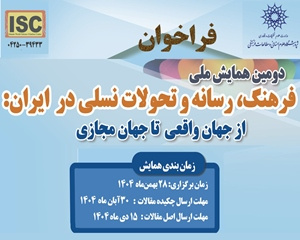شناسایی و سطح بندی عوامل دخیل در تنظیم بازار کالاهای اولویت دار مبتنی بر حکمرانی شبکه ای با رویکرد مدل سازی ساختاری تفسیری (مقاله علمی وزارت علوم)
درجه علمی: نشریه علمی (وزارت علوم)
آرشیو
چکیده
هدف: با تحولات گسترده در اقتصاد و جامعه و پیچیده تر شدن مسائل و ناتوانی دولت ها، شکل های شبکه ای حکمرانی به طور روزافزونی در کانون قرار گرفته است. از جمله حوزه های مهم و عمومی جامعه که قابلیت کاربست حکمرانی شبکه ای را دارد، حوزه تنظیم بازار کالاهای اولویت دار است. از این رو پژوهش حاضر به طراحی مدل تنظیم بازار کالاهای اولویت دار با بهره گیری از رویکرد حکمرانی شبکه پرداخته است.روش: روش پژوهش آمیخته اکتشافی است و از تلفیق دو روش تحلیل مضمون براساس مصاحبه با خبرگان و ملاحظه اسناد و مدارک کیفی و مدل سازی ساختاری تفسیری استفاده شده است. جامعه آماری پژوهش در هر دو مرحله کیفی و کمّی، خبرگانی از حوزه تنظیم بازار بوده است که به روش نمونه گیری هدفمند انتخاب شده اند. ابزار گردآوری داده ها در بخش کیفی، مصاحبه نیمه ساختار یافته، اسناد و مدارک کیفی و در بخش کمّی پرسش نامه ساختاری تفسیری است.یافته ها: مدل استخراج شده، از هفت سطح شکل گرفته است که مضامین آن عبارت اند از: تنوع بازیگران، منابع انسانی متخصص و منعطف، حوزه های کارکردی شبکه، سطوح خط مشی گذاری شبکه، زیرساخت های قانونی و اطلاعاتی، تأمین منابع مالی، استراتژی و جهت گیری شبکه، کنترل و نظارت چندسطحی، پشتیبانی شبکه تنظیم بازار، چرخه خط مشی گذاری شبکه و مدیریت شبکه.نتیجه گیری: در مدل به دست آمده، تنوع بازیگران شبکه زیربنایی ترین سطح مدل محسوب می شود. این بازیگران نهادهای تخصصی و نیمه تخصصی ای هستند که به شکل غیرمستقیم بر تنظیم بازار تأثیر می گذارند. منابع انسانی متخصص و منعطف در سطر ششم مدل قرار گرفت. آشنایی تصمیم گیران حوزه تنظیم بازار با مباحث تنظیم بازار، شبکه و فناوری اطلاعات و ارتباطات حائز اهمیت است. حوزه های کارکردی شبکه در سطر پنج قرار گرفت که حوزه های کارکردی تأمین و ذخیره سازی، توزیع، لجستیک و زیرساخت های تجاری و قیمت را دربرمی گیرد. سطوح خط مشی گذاری شبکه در سطر چهارم قرار گرفت که تدوین سیاست های افقی، عمودی و غیره را شامل می شود. سطح سوم شامل زیرساخت های قانونی و اطلاعاتی و منابع مالی است. برای تحقق مطلوب ترین نتایج از حکمرانی شبکه در تنظیم بازار، داشتن زیرساخت های قانونی و فناوری اطلاعاتی، رکن مهمی است و می بایست مطابق ارتباطات شبکه ای میان بازیگران، زیرساخت های فناوری نیز توسعه یابد. در موضوع تأمین مالی شبکه تنظیم بازار، تأمین مالی مناسب و به موقع منابع ریالی و ارزی، اهمیت اساسی دارد. استراتژی و جهت گیری شبکه و کنترل و نظارت چندسطحی در سطر دوم قرار گرفت. در رویکرد شبکه ای تنظیم بازار، استراتژی ها و جهت گیری های بازار، می بایست به سمت رویکرد خودتنظیم، پایین به بالا، اجتماعی و گفت وگومحور و تفاهمی باشد. در شبکه تنظیم بازار می بایست نظارت عالیه برعهده دولت باشد، نظارت توسط واحدهای صنفی انجام شود و مردم نیز در نظارت میدانی مشارکت کنند. در چرخه خط مشی گذاری، سیاست گذاری در کارگروه تنظیم بازار، تقسیم کار ملی و استانی، اجرا و اطلاع رسانی به همراه رصد و پایش سیاست ها و برنامه ها واجد اهمیت است. در شبکه تنظیم بازار، مدیریت نقش پاسخ گو کردن بازیگران و شفافیت شبکه و غیره را برعهده دارد. در پشتیبانی شبکه، جلوگیری از دسترسی غیرمجاز به منابع شبکه تنظیم بازار، شناسایی و متوقف کردن حملات سایبری و نقض امنیت داده ها و غیره مطرح است.Identification and Classification of Factors Influencing the Regulation of Priority Goods Markets Based on Network Governance with an Interpretive Structural Modeling Approach
ObjectiveThe increasing complexity within economies and societies, coupled with the limited capacity of governments to address these challenges, has brought network forms of governance into focus. Traditional interactions between the market—how households and firms connect—and government interventions have consistently presented challenges across various economic sectors. Predominantly, governmental organizations have been structured on hierarchical principles, wherein managers must navigate authority, law compliance, and accountability. These managers have traditionally embraced hierarchical management styles. However, the emergence of the New Public Management movement in the 1980s also introduced market governance. Additionally, network governance has become essential, particularly as solitary public sector efforts have proven inadequate in solving complex social issues. This increased societal pressure for cooperation and co-production with the community, rather than mere governance. An area where network governance can be effectively applied is in the regulation of priority goods markets. This study, therefore, proposes a model for regulating the priority goods market using a network governance approach.MethodsThis research utilizes an exploratory mixed-method design, combining thematic analysis—from expert interviews and document reviews—with interpretive structural modeling (ISM). The study targets market regulation experts, selected through purposive sampling, as the statistical population for both qualitative and quantitative phases. The data collection tools include semi-structured interviews and qualitative document analysis in the qualitative phase, and structured interpretive questionnaires in the quantitative phase.ResultsThe model developed comprises seven levels, encompassing actor diversity, specialized and flexible human resources, and various functional domains of the network. These domains range from policy-making within the network to the legal and informational infrastructure, financial resource allocation, network strategy and orientation, multi-level control and oversight, market regulation network support, network policy cycles, and network management.ConclusionThe diversity of network actors forms the foundation of the model, featuring specialized, semi-specialized, and indirectly influential institutions in market regulation. Specialized and flexible human resources are recognized as critical, positioned prominently within the model. Effective market regulation requires decision-makers who are well-versed in network dynamics and information and communication technology. The functional areas of the network, including supply, storage, distribution, logistics, commercial infrastructure, and pricing, are integral to the model. The formulation of both horizontal and vertical policies within network policy-making is crucial for cohesion and effectiveness. Legal and information technology infrastructures, alongside financial resources, form the third level, emphasizing the necessity for robust legal frameworks and technological connectivity among stakeholders. Financing strategies for the market regulation network must ensure timely and appropriate allocation of both local and foreign currency resources. The model places strategic direction and multi-level oversight near the top, advocating for a self-regulatory, bottom-up approach that fosters social dialogue and understanding. Government oversight remains paramount, with trade unions playing a supervisory role and public participation in field supervision. Policy cycles within the market regulation network should facilitate a clear division of labor, implementation, and rigorous monitoring at both national and provincial levels. Lastly, network management should focus on transparency and accountability among all actors. Additionally, network support must prioritize safeguarding against unauthorized access and cyber threats to maintain the integrity of market regulation network resources.



